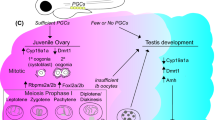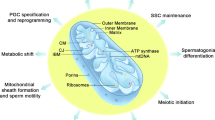Summary
Previous studies indicate that the genes controlling cell-specific functions in extant metazoans derive from housekeeping genes of their unicellular ancestors. Traces of such relationships can be found in the gene families controlling signal reception at cell surfaces and light condensation in eye lens. We present other examples of gene remodeling taken in the field of germ cell-specific proteins. In amphibian oocytes several proteins contribute to edification of an efficient translation machinery for the future embryo. Some RNA components of this machinery have to be protected against degradation during growth of the oocytes in the ovary. The protective function is served by a small group of RNA-binding proteins deriving from universal transcription or translation factors. Several of those proteins are bifunctional.
Similar content being viewed by others
References
Abdallah B, Hourdry J, Deschamps S, Denis H, Mazabraud A (1991a) The genes encoding the major 42S storage particle proteins are expressed in male and female germ cells of Xenopus laevis. Development 113:851–856
Abdallah B, Hourdry J, Krieg A, Denis H, Mazabraud A (1991b) Germ cell-specific expression of a gene encoding eukaryotic translation initiation factor 1α (eEF-1α) and generation of eEF-1α retropseudogenes in Xenopus laevis. Proc Natl Acad Sci USA 88:9277–9821
Baker ME (1988a) Is vitellogenin an ancestor of apolipoprotein B-100 of human low-density lipoprotein and human lipoprotein lipase? Biochem J 255:1057–1060
Baker ME (1988b) Invertebrate vitellogenin is homologous to human von Willebrand factor. Biochem J 2563:1059–1063
Blanck A, Oesterhelt D (1987) The halo-opsin gene. II. Sequence, primary structure of halorhodopsin and comparison with bacteriorhodopsin. EMBO J 6:265–273
Bourne HR (1988) Summary: signals past, present and future. Cold Spring Harb Symp Quant Biol 53:1019–1031
Brown RS, Sander C, Argos P (1985) The primary structure of transcription factor TFIIIA has 12 consecutive repeats. FEBS Lett 186:271–274
Buck L, Axel R (1991) A novel multigene family may encode odorant receptors: a molecular basis for odor recognition. Cell 65:175–187
Byrne BM, Gruber M, AB G (1989) The evolution of egg yolk proteins. Prog Biophys Mol Biol 53:33–69
Darnbrough CH, Ford PJ (1981) Identification in Xenopus laevis of a class of oocyte-specific proteins bound to messenger RNA. Eur J Biochem 113:415–424
de Jong WW, Hendriks W, Mulders JWM, Bloemendal H (1989) Evolution of eye lens crystallins: the stress connection. Trends Biochem Sci 14:365–368
Denis H, le Maire M (1983) Thesaurisomes, a novel kind of nucleo-protein particles. Subcell Biochem 9:263–297
Denis H, le Maire M (1985) Biochemical research on oogenesis. Aminoacyl tRNA turns over in the 42-S particles of Xenopus oocytes, but its ester bond is protected against hydrolysis. Eur J Biochem 149:549–556
Deschamps S, Viet A, Garrigos M, Denis H, le Maire M (1992) mRNP4, a major mRNA-binding protein from Xenopus oocytes is identical to transcription factor FRG Y2. J Biol Chem 267:13799–13802
Djé M, Mazabraud A, Viet A, le Maire M, Denis H, Crawford E, Brown DD (1990) Three genes under different developmental control encode elongation factor 1-α in Xenopus laevis. Nucleic Acids Res 18:3489–3493
Doolittle RF (1985) The genealogy of some recently evolved vertebrate proteins. Trends Biochem Sci 10:233–237
Dunn R, McCoy J, Simsek M, Majumdar A, Chang SH, RajBhandary UL, Khorana HG (1981) The bacteriorhodopsin gene. Proc Natl Acad Sci USA 78:6744–6748
Fields S (1990) Pheromone response in yeast. Trends Biochem Sci 15:270–273
Gilbert W, Marchionni M, McKnight G (1986) On the antiquity of introns. Cell 46:151–154
Hellingwerf KH (1988) Phylogenetic relations between unicellular organisms and the mechanism of vertebrate signal transduction. Trends Biochem Sci 13:129
Honda BM, Roeder RG (1980) Association of a 5S gene transcription factor with 5S RNA and altered levels of the factor during cell differentiation. Cell 22:119–126
Ingram VM (1961) Gene evolution and the haemoglobins. Nature 189:704–708
Joho KE, Darby MK, Crawford ET, Brown DD (1990) A finger protein structurally similar to TFIIIA that binds exclusively to 5S RNA in Xenopus. Cell 61:293–300
Kaziro Y, Itoh H, Kozasa R, Toyama R, Tsukamoto T, Matsuoka M, Nakafuku M, Obara T, Kakagi T, Hernandez R (1988) Structure of the genes coding for G-proteins a subunits from mammalian and yeast cells. Cold Spring Harb Symp Quant Biol 53:209–220
Kim SH, Darby MK, Joho K, Brown DD (1990) The characterization of the TFIIIA synthesized in somatic cells of Xenopus laevis. Genes Dev 4:1602–1610
Kirk DL (1988) The ontogeny and phylogeny of cellular differentiation in Volvox. Trends Genet 4:32–36
Kubo T, Fukuda K, Mikami A, Maeda A, Takahashi H, Mishina M, Haga T, Haga K, Ichiyama A, Kangawa K, Kojima M, Matsuo H, Hirose T, Numa S (1986) Cloning, sequencing and expression of complementary DNA encoding the muscarinic acetylcholine receptor. Nature 323:411–416
Lagaye S, Barque JP, le Maire M, Denis H, Larsen CJ (1989) Characterization by human antibodies of two HeLa cell proteins which are related to Xenopus laevis transcription factor TFIIIA. Nucl Acids Res 105:11–16
Masu Y, Nakayama K, Tamaki H, Harada Y, Kuno M, Nakanishi S (1988) cDNA cloning of bovine substance-K receptor through oocyte expression system. Nature 329:836–838
Mattaj IW, Coppard NJ, Brown RS, Clark BFC, De Robertis EM (1987) 42Sp48—the most abundant protein in previtellogenic Xenopus oocytes—resembles elongation factor 1α structurally and functionally. EMBO J 6:2409–2413
Miller J, McLachlan AD, Klug A (1985) Repetitive zinc-binding domains in the protein transcription factor IIIA from Xenopus oocytes. EMBO J 4:1609–1614
Murray MT, Schiller DL, Franke WW (1992) Sequence analysis of cytoplasmic mRNA-binding proteins of Xenopus oocytes identifies a family of RNA-binding proteins. Proc Natl Acad Sci USA 89:11–15
Nardelli D, Gerber-Huber S, van het Schip FD, Gruber M, AB G, Wahli W (1987) Vertebrate and nematode genes coding for yolk proteins are derived from a common ancestor. Biochemistry 26:6397–6402
Nathans J, Hogness DS (1983) Isolation, sequence analysis, and intron-exon arrangement of the gene encoding bovine rhodopsin. Cell 34:807–814
Pelham HRB, Brown DD (1980) A specific transcription factor that can bind either the 5S RNA gene or 5S RNA. Proc Natl Acad Sci USA 77:4170–4174
Picard B, le Maire M, Wegnez M, Denis H (1980) Biochemical research on oogenesis. Composition of the 42-S storage particles of Xenopus laevis oocytes. Eur J Biochem 109:359–368
Picard B, Wegnez M (1979) Isolation of a 7S particle from Xenopus laevis oocytes: a 5S RNA-protein complex. Proc Natl Acad Sci USA 76:241–245
Saxe CL, Klein P, Sun TJ, Kimmel AR, Devreotes PN (1988) Structure and expression of the cAMP cell-surface receptor. Dev Genet 9:227–235
Seifart KH, Wang L, Waldschmidt R, Jahn D, Wingender E (1989) Purification of human transcription factor IIIA and its interaction with a chemically synthesized gene encoding human 5 S RNA. J Biol Chem 264:1702–1709
Shastry BS, Honda BM, Roeder RG (1984) Altered levels of a 5S gene-specific transcription factor (TFIIIA) during oogenesis and embryonic development of Xenopus laevis. J Biol Chem 259:11373–11382
Starr RC (1969) Structure, reproduction, and differentiation in Volvox carteri f. nagariensis IYENGAR, strains HK 9 & 10. Arch Protistenk 111:204–222
Tafuri SR, Wolffe AP (1990) Xenopus Y-box transcription factors: molecular cloning, functional analysis, and developmental regulation. Proc Natl Acad Sci USA 87:9028–9032
Trewitt PM, Heilmann LJ, Degrugillier SS, Kumaran AK (1992) The boll weevil vitellogenin gene: nucleotide sequence, structure, and evolutionary relationship to nematode and vertebrate vitellogenin genes. J Mol Evol 34:478–492
van den Eynde H, Mazabraud A, Denis H (1989) Biochemical research on oogenesis. RNA accumulation in the oocytes of the newt Pleurodeles waltl. Development 105:11–16
Viet A, Armand MJ, Callen JC, Gomez de Gracia A, Denis H, le Maire M (1990) Elongation factor 1α (EF-1α) is concentrated in the Balbiani body and accumulates coordinately with the ribosomes during oogenesis of Xenopus laevis. Dev Biol 141:270–278
Viet A, le Maire M, Philippe H, Morales J, Mazabraud A, Denis H (1991) Structural and functional properties of thesaurin a (42Sp50), the major protein of the 42 S particles present in Xenopus laevis previtellogenic oocytes. J Biol Chem 266:10392–10399
Wang CK, Weil PA (1989) Purification and characterization of Saccharomyces cerevisiae transcription factor IIIA. J Biol Chem 264:1092–1099
Wistow GJ, Piatigorsky J (1988) Lens crystallins: the evolution and expression of proteins for a highly specialized tissue. Ann Rev Biochem 57:479–504
Author information
Authors and Affiliations
Additional information
Offprint requests to: H. Denis
Rights and permissions
About this article
Cite this article
Mazabraud, A., Wegnez, M. & Denis, H. Origin of several abundant proteins of amphibian oocytes. J Mol Evol 35, 546–550 (1992). https://doi.org/10.1007/BF00160215
Received:
Accepted:
Issue Date:
DOI: https://doi.org/10.1007/BF00160215




